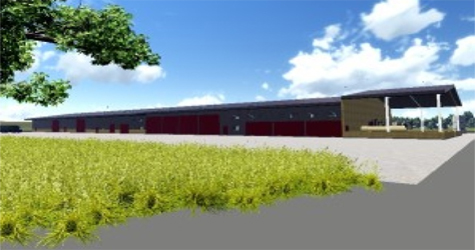Northumberland Estate are supporting a newly-built renewable energy plant fed by a relocated sawmill.
Northumberland Gazett recently announced that Northumberland Estates are supporting a project in Alnwick, and application to the county council has been submitted.
A Trail-blazing £6million green scheme is being lined up for a north Northumberland industrial estate, which could see a newly-built renewable energy plant fed by a relocated sawmill.
Northumberland Estates is behind the project at Lionheart Enterprise Park, on the edge of Alnwick, and has submitted a planning application to the county council.
Using cutting-edge technology, it has the potential to put the town ahead of the game in terms of renewable energy production, by using woodchip from sustainable sources on the Duke’s estate to fuel what is known as a Combined Heat and Power (CHP) plant.
It has the capacity to produce around one megawatt of green electricity per annum – enough to power between 1,500 and 1,800 homes.
And at the same time, Northumberland Estates would relocate its sawmill to the same site, bringing the two operations together.
Graham Caygill, clerk of works at Northumberland Estates, said: “We have put a huge amount of time and effort into researching this project over a number of years and believe it could be really exciting for Alnwick. We looked closely into several different types of renewable technology before settling on CHP and have visited operational CHP plants of this size and bigger as far afield as Austria and Italy, as well as a newly-built production plant in Turkey.
“The estate has over 4,000 hectares of forestry, so with this in mind we decided to explore renewable energy generation from woodchip.
“Having analysed many different types of energy generation we have settled on a technology which uses a process called pyrolysis.”
At its most simplistic, pyrolysis involves heating the woodchip to a very high temperature but without oxygen being present, so that the wood does not burn.
Instead, it decomposes rapidly, giving off a gas which can then be used to run the machinery required to produce electricity, as well as a harmless carbon product called char.
Heat is another by-product, but unlike burning, pyrolysis is not noisy or smelly and produces no emissions or smoke, dioxins or other pollutants, and is a carbon-neutral process.
The entire wood chip supply would be locally sourced in the form of thinnings produced by regular maintenance of the Estate’s woods, plus other virgin wood material from the sawmill. The CHP plant itself would be housed in an industrial unit of the type already in existence at Lionheart, being approximately 1,000 square metres in size.
“It makes sense for the CHP plant to be located alongside the sawmill if we are to avoid wasting energy on transport,” said Mr Caygill. “Another advantage of the Lionheart site is that it allows us to make best use of the heat which is also generated during the process thus extending the renewables remit.
“We are proposing using this heat at the sawmill for drying with any surplus potentially turned into green heating for use by offices and other businesses in the immediate vicinity.”
Northumberland Estates already has a highly pro-active renewable energy policy, which has seen a Victorian hydro system restored to use on the River Aln, with plans to extend it to other locations in the near future.
Solar panels have also been installed on industrial units in Alnwick and all the Estate’s new housing and other development schemes embrace green technology, including combined heat and power schemes for heating, grey water use and recycling.
Mr Caygill said: “If successful, this project would be the largest to date and would put the Estate at the cutting edge of this technology.”








